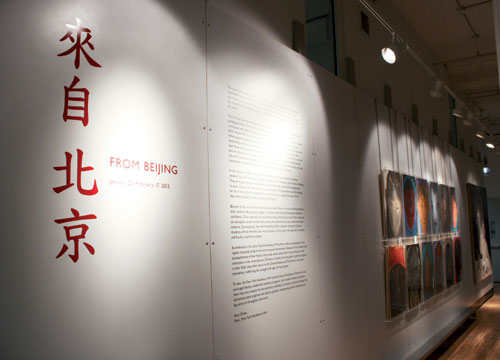Oil riches flow from Beijing to New York with fine art
|
 From Beijing includes works from 21 world-renowned contemporary painters including Liu Xiaodong, Zhang Dali, Liu Gang and Zhang Huan. Provided to China Daily? |
Although oil painting is a classical tradition in the West, the medium was only introduced to China at the beginning of the 20th century. A new exhibition at the New York Academy of Art showcases oil paintings by professors at Beijing's prestigious Central Academy of Fine Arts, widely considered the country's preeminent art program.
On display untill Feb 17, From Beijing includes work from 21 world-renowned contemporary painters, including Liu Xiaodong, Zhang Dali, Liu Gang and Zhang Huan. CAFA's academic staff comprises some of the country's most successful artists.
"Since this is the first presentation of CAFA as an entity in NYC, it was important to us to show them at their best," said Peter Drake, the fine-arts academy's dean of academic affairs. "These are all extremely prominent artists in China. My sense is that in China there is a reverence for accomplishment and for senior faculty, and a respect for the contributions they've made to their field. It's a little different from how it is in US, where often people believe that those that can't do, teach-it's a different mentality there."
The two schools have built a collaborative relationship, beginning in 2011 with a Beijing residency program for NYAA students that will continue into its third summer this year. As part of the exchange, four students spend two months at CAFA and Shanghai University, receiving invaluable training at state-of-the-art facilities, Drake said. Both schools also have hosted visiting artists and lecturers.
Xie Dongming, CAFA's vice-president and the dean of its oil painting department, said the relationship has been mutually beneficial. "The two schools have been building toward a strong ongoing academic partnership," he said. "In many aspects, we can learn from each other. We can complement each other through understanding our differences and similarities."
This exhibition is the culmination of that relationship, Drake said. NYAA's strong focus on technical training makes for a natural partnership with CAFA, he said.
In an accompanying program, he writes: "The story of how the exhibition came to be is in part the story of the migration of a pedagogical ideal. The French Academy is central to the plot, as the rigorous conceptual and technical training at the heart of the French academic model epitomizes both schools. This is unusual for graduate schools of art, particularly in the West where pluralist programs are almost universally the norm. The unusually high standards, demanding instruction and focused coursework that define both schools set them apart from their contemporaries and suggest a new model for art instruction."
One major difference between the schools is that China's art history has been deeply influenced by social realism, a style that de-emphasized accurate anatomy in the way it's taught in US schools, Drake said. As a result, CAFA has expressed interest in learning more about how NYAA teaches anatomical studies today, he said.
On the other hand, NYAA has been inspired by CAFA's focus on "the tradition of reinvesting in the language of painting", he said. Many US graduate programs focus less on training, with the assumption that technique has been learned in undergraduate studies.
"We are very interested in this idea of re-examining the pedagogical history of art training in America, which CAFA exemplifies," he said.
Western viewers might be surprised at the use of oil painting in contemporary Chinese art, said Elizabeth Hobson, director of marketing and events at NYAA. With so much of the world focused on "the abstract and the different", schools like NYAA and CAFA are unique in that they provide traditional training in technique while also actively encouraging students to engage in the contemporary art world, she said.
Included in the exhibition is a large-scale piece called Ark by Yu Hong, an artist who has exhibited at renowned art spaces including the Pierre Cardin Arts Centre in Paris and Goedhuis Contemporary in New York. She believes that CAFA is China's most representative fine arts school.
"One could say that (CAFA's) development epitomizes the development of new Chinese art," she said. "They have China's first flux of painters as their professors and they have China's first flux of students. It goes without saying they have a great influence on Chinese art. The association of these two schools through academic exchanges can allow (both schools) to have a great understanding behind the societal origin of cultural phenomenon."
While oil painting is not necessarily in vogue today, it remains an important medium, she said.
"On one side, due to the changing patterns of the world, China and Chinese contemporary art increasingly receive the world's attention," she said. "On the other side, when we reexamine realist painting, after having experienced a long period of marginalization, we discover that for the purpose of contemporary art, it can maybe provide new possibilities.
"I hope that this exhibition allows Western audiences to see more of these outstanding Chinese contemporary artists with art that not only concerns China, but also concerns the broader world and human nature."
Also on display are two self-portraits by Liu Xiaodong, whose panorama, Three Gorges: Newly Displaced Population, sold for $2.75 million in 2006, the most paid for a contemporary Asian work at that time.
"This exhibition is a terrific opportunity for not only the US audience, but also the global audience, to observe the state of contemporary oil painting in China, which I believe will provide a vital boost to the cultural exchanges between China and the world," Xie said. "This show brings an aspect of highly diverse Chinese contemporary oil painting, as well as a reflection of a changing China."
kdawson@chinadailyusa.com
























